Continue Play Rs3 or Move to Os
"POH" redirects here. For the pirate quest, see Pieces of Hate.

A player-owned house (often shortened to POH) can be bought from an estate agent and created, expanded, and upgraded by members. It is the result of a player's efforts in the Construction skill.
Player-owned house basics
Purchasing a house
To get started, players must first buy a house. This can be done by paying one of the five Estate Agents. The house will cost 1000 coins, and it will be located in Taverley by default. Players buying their house for the first time will automatically complete the task 'Unreal Estate, Man' which rewards the player 256-1024 coins. The Estate agents can be found in 5 locations:
- Seers' Village, northeast of the bank.
- Falador, west of the east bank.
- Ardougne, west of the south bank.
- Varrock, north of the east bank.
- Prifddinas, in the Ithell Clan section. (Level 75 Construction required.)
Otot can also be a location for players' houses, but there is no estate agent there. This is unlocked upon reaching the seventh reputation level among the Goebies (level 60 Construction is required).
Travelling to house portals
The most basic way to get to a house is by walking to the portal that is in the location of the house. At level 40 Magic, players can use the Teleport to House spell to teleport directly into the player's own house. Using a house teleport tablet is another option that only uses one inventory space and does not require a magic level to use. In the house options screen, players can choose whether the house teleports land the player in the house itself or outside the portal. After completion of Love Story, players can use altered house teleport tablets to teleport to any portal regardless of their house location.
Entering the portal
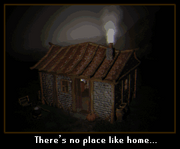
The house loading screen
By clicking on a portal, players will be asked if they want to either enter their own house, enter their own house with building mode on, or enter a friend's house. Players can only access houses that are at the location of the portal. When entering a house, the player will be shown a loading screen and a music jingle will play.
House portal locations
Estate agents can move a player's house from its starter location in Taverley to any of the other house portal locations identified by the portal ![]() icon on the map. These locations are Rimmington, Pollnivneach, Rellekka, Brimhaven, Yanille, Prifddinas, and Menaphos. Each location requires a certain Construction level, and the estate agent charges a fee for each move. The details are shown in the table below, along with potential benefits of each location.
icon on the map. These locations are Rimmington, Pollnivneach, Rellekka, Brimhaven, Yanille, Prifddinas, and Menaphos. Each location requires a certain Construction level, and the estate agent charges a fee for each move. The details are shown in the table below, along with potential benefits of each location.
| Portal Location | Level Required | Cost to Relocate (after tasks) | Portal Location on Map | Potential Benefits |
|---|---|---|---|---|
| Rimmington | 1 | 5,000 (2,500) | 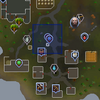 |
|
| Taverley | 10 | 5,000 (2,500) | 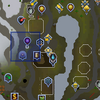 |
|
| Pollnivneach | 20 | 7,500 (3,750) | 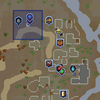 |
|
| Rellekka | 30 | 10,000 (5,000) | 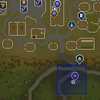 |
|
| Brimhaven | 40 | 15,000 (7,500) | 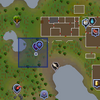 |
|
| Yanille | 50 | 25,000 (12,000) | 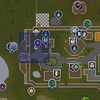 |
|
| Menaphos | 50 (The Jack of Spades) | 50,000 (25,000) | 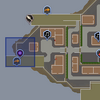 |
|
| Otot | 60 (1,750 reputation) | 50,000 (25,000) | 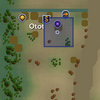 |
|
| Prifddinas | 75 (Plague's End) | 50,000 (25,000) |  |
|
House styles - Redecorating
Estate agents can also redecorate the player's house for a fee. Parts of the house that can be redecorated include:
- Walls and interior flooring
- Exterior ground
- Dungeon walls and flooring
- Lighting
Each house style comes with a unique tune that plays upon entering the house. All of the styles (with the exception of the Zenevivia Dark Stone) are based on buildings and areas around POH portals. The costs are cut in half after completion of the Varrock elite tasks.
| Walls and interior flooring | Level required | Cost (after tasks) | Styled like | Entrance jingle |
|---|---|---|---|---|
| Basic Wood | | 2,500 (1,250) coins | Retro Rimmington | |
| Basic Stone | | 5,000 (2,500) coins | Retro Burthorpe | |
| Whitewashed Stone | | 7,500 (3,750) coins | Pollnivneach | |
| Fremennik-Style Wood | | 10,000 (5,000) coins | Rellekka | |
| Tropical Wood | | 15,000 (7,500) coins | Brimhaven | |
| Fancy Stone | | 25,000 (12,500) coins | Falador | |
| Dark Stone | | Free | The Wise Old Man's POH |
| Grounds | Level required | Cost (after tasks) |
|---|---|---|
| Rough Grass | | 5,000 (2,500) coins |
| Desert | | 7,500 (3,750) coins |
| Barren Earth | | 10,000 (5,000) coins |
| Mown Grass | | 15,000 (7,500) coins |
| Tundra | | 100,000 (50,000) coins |
| Dungeon walls and flooring | Level required | Cost (after tasks) |
|---|---|---|
| Rough Stone | | 2,500 (1,250) coins |
| Smooth Stone | | 5,000 (2,500) coins |
| Desert Dungeon | | 7,500 (3,750) coins |
| Mountain Mine | | 10,000 (5,000) coins |
| Tropical Cave | | 15,000 (7,500) coins |
| Stone Blocks | | 25,000 (12,500) coins |
| Lighting | Level required | Cost (after tasks) |
|---|---|---|
| Day | | 5,000 (2,500) coins |
| Dusk | | 150,000 (75,000) coins |
| Night | | 250,000 (125,000) coins |
Building a house
Your first house starts off with only a parlour and garden, but new rooms and furniture can be easily built.
Building mode
In order to begin customising a house, a player must enter their house with building mode turned on. This can be done either by entering portal in building mode or by changing the building mode settings in house options of the options menu. If you change the setting in your options menu while not in a house, you will automatically be in building mode the next time you teleport to your house using the teleport or teleport tablet. You cannot drop items while in building mode and familiars are not allowed either. Building mode cannot be turned on while guests are in the house.
Adding new rooms
While in building mode, players will see white doors in the entryways of all their rooms. Right-clicking on these and selecting build will allow the player to see a menu of all the rooms that can be built attached to that door. The player will also see the level requirement and the price of the new room. When a room is selected, the player will see a ghost version of the new room, and will be able to rotate the room to any desired rotation provided that the doorways line up. If a room is occupying the spot the player wants to build, they are given the option to remove it, unless it is a menagerie or costume room, where it is moved instead to that location for the building fee.
Removing rooms
A room can be removed in building mode by right-clicking the door to the room and selecting the build option. This brings up a prompt asking if you want to remove the room. You cannot remove a room on the ground level that is supporting another room on the first floor. This rule does not apply to dungeon rooms under the ground level rooms.
It is advisable to remove all the built items in a room before removing the room. In most cases, nothing is gained by removing items, but in some cases items are recovered. For example, armour, swords, and capes that are part of a display can be recovered. An exception to this is the Shattered Hearts statue in the Study. If you destroy the statue first, you will have to rebuild it from the beginning. However, if you destroy the entire study instead, building a new plinth will restore the statue with all of the pieces you had before.
Moving rooms
Players can only move three rooms: the Menagerie, the Costume room and the Aquarium. To move one, simply attempt to build the room in the new location. Do not remove the current room. Players will be told that they can only have one of the room and will be asked if they want to move it to the new location. Upon selecting "yes", the player will be prompted to choose the rotation of the new room. The new room (after being relocated) will have all the same items, furniture and pets as it had at the old location. The player will still have to pay the cost of building the room in order to move it.
Remember, the only way to move the other rooms is to delete it and rebuild it in the desired new location. Rooms such as a chapel, throne room, study, and dungeon rooms, once filled with expensive gilded/opulent furniture, are not recommended to be moved. Jagex has looked into the ability to move rooms, but it currently isn't possible to move rooms that the player can have multiples of due to technical limitations.
Planning the layout
It is essential to plan your house layout using tools found on fansites or a sheet of paper because it will save you millions of coins. This is because all but four rooms, the Menagerie, Costume room, Games room, and Aquarium, cannot be moved without destroying the inside furniture and contents. Furthermore, a well planned house looks much more impressive and is often more efficient to use for training and transportation.
The most important point to consider when designing the layout is what rooms are placed next to the garden portal. For beginning players, the Workshop or Kitchen can be the best rooms next to the portal because they offer fast training methods such as building flatpacks or larders. Portal Chambers are very useful to place directly adjacent to the portal, since this allows quick and easy access to teleports for when players wish to use their house as a teleport hub. Another room that is often put near the portal is a Chapel, which will allow players to train and recharge prayer more quickly.
Another important point to consider when building a house is which direction that rooms face. While this is not a huge concern for most rooms, some orientations can make moving through the house much faster. For example, normal staircases can be annoying if built facing the wrong direction unlike Spiral staircases, which can be accessed from any side. When a staircase is added to a Skill Hall, it will connect to the room above or below by default if and only if the room is facing the proper direction. If the room is not, then one of the rooms will have to be removed and rebuilt in order to secure a connection. This restriction is in effect for both normal staircases and, even though they do not have a "direction", spiral staircases. Another good example is the orientation of the exit portal.
The garden trick
There is a useful and fairly cheap trick that can be used to separate the rooms in a player-owned house so they can function as separate buildings. This allows for a diversity of buildings in a house to crop up, and allows functions such as shops, guest houses, even towers to form, creating a player-owned city. It is useful and inexpensive. This is caused by a person building rooms at parallel locations and separating them with gardens, example: Parlour-Garden-Parlour. The two parlours would act as separate buildings, and you could then remove the garden (provided there is still one left for the portal) to save space.
Rooms
There are 22 different types of rooms that can be added to a house. Different rooms require different Construction levels and cost a substantial amount of coins. Boosts (such as tea) can be used to meet level requirements for building rooms. All rooms in a house are the same size (8 x 8 squares). Attempting to build a second aquarium, menagerie, costume room, or games room prompts the player to move their existing one instead, for the same cost as building a new one.
| Room | Construction Level | Cost to Build | Uses | Doors | ||||||||||||||||||||||||||||
|---|---|---|---|---|---|---|---|---|---|---|---|---|---|---|---|---|---|---|---|---|---|---|---|---|---|---|---|---|---|---|---|---|
| | Garden | 1 | 1,000 |
|
| |||||||||||||||||||||||||||
| | Parlour | 1 | 1,000 |
|
| |||||||||||||||||||||||||||
| | Kitchen | 5 | 5,000 |
|
| |||||||||||||||||||||||||||
| | Dining Room | 10 | 5,000 |
|
| |||||||||||||||||||||||||||
| | Workshop | 15 | 10,000 |
|
| |||||||||||||||||||||||||||
| | Bedroom | 20 | 10,000 |
|
| |||||||||||||||||||||||||||
| | Skill Hall | 25 | 15,000 |
|
| |||||||||||||||||||||||||||
| | Games room | 30 | 25,000 |
|
| |||||||||||||||||||||||||||
| | Combat Room | 32 | 25,000 |
|
| |||||||||||||||||||||||||||
| | Quest Hall | 35 | 25,000 |
|
| |||||||||||||||||||||||||||
| | Menagerie | 37 | 30,000 |
|
| |||||||||||||||||||||||||||
| | Study | 40 | 50,000 |
|
| |||||||||||||||||||||||||||
| | Costume Room | 42 | 50,000 |
|
| |||||||||||||||||||||||||||
| | Chapel | 45 | 50,000 |
|
| |||||||||||||||||||||||||||
| | Portal Chamber | 50 | 100,000 |
|
| |||||||||||||||||||||||||||
| | Formal Garden | 55 | 75,000 |
|
| |||||||||||||||||||||||||||
| | Throne Room | 60 | 150,000 |
|
| |||||||||||||||||||||||||||
| | Aquarium | 63 | 200,000 |
|
| |||||||||||||||||||||||||||
| | Oubliette | 65 | 150,000 |
|
| |||||||||||||||||||||||||||
| | Dungeon | 70 | 7,500 |
|
| |||||||||||||||||||||||||||
| | Dungeon Pit | 70 | 10,000 |
|
| |||||||||||||||||||||||||||
| | Treasure Room | 75 | 250,000 |
|
| |||||||||||||||||||||||||||
Size limitations
There are several limitations that players must follow when building their house. In addition, players are restricted to a maximum number of rooms and a maximum house dimension based on their construction level. See the chart below.
- Houses may only have up to 3 levels: 1 below ground, the ground floor, and 1 above ground.
- Rooms on the level above the ground floor require a room built below them on the ground floor first. Removing/replacing the room on the ground floor later requires the upper room to be removed first.
- Gardens, formal gardens, menagerie, aquariums, and throne rooms can only be built on the ground floor. Dungeon rooms (Dungeon stairs, corridor, junction, pit, oubliette and treasure room) can only be built underground.
- Rooms may not be built above menagerie, gardens, or formal gardens.
- When the area of land upgrades to the next area size, an extra row of land appears on the north and east sides.
| Construction level | Maximum number of rooms | Maximum area of land |
|---|---|---|
| 1 | 21 | 3 x 3 |
| 15 | 21 | 4 x 4 |
| 30 | 21 | 5 x 5 |
| 38 | 22 | 5 x 5 |
| 44 | 23 | 5 x 5 |
| 45 | 23 | 6 x 6 |
| 50 | 24 | 6 x 6 |
| 56 | 25 | 6 x 6 |
| 60 | 25 | 7 x 7 |
| 62 | 26 | 7 x 7 |
| 68 | 27 | 7 x 7 |
| 74 | 28 | 7 x 7 |
| 80 | 29 | 7 x 7 |
| 86 | 30 | 7 x 7 |
| 92 | 31 | 7 x 7 |
| 96 | 32 | 7 x 7 |
| 99 | 33 | 7 x 7 |
Furniture
See the Constructed items list for details on what players can build at the hotspots of each room at a specific level.
- Levels 1 to 24: Constructed items (1-24)
- Levels 25 to 50: Constructed items (25-50)
- Levels 51 to 74: Constructed items (51-74)
- Levels 75 to 99: Constructed items (75-99)
Furniture hotspots
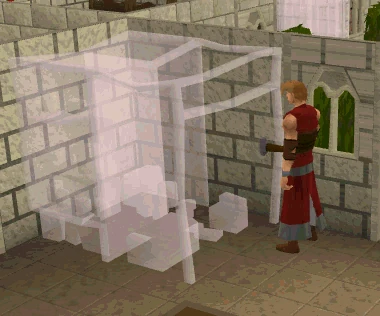
A player builds a larder and destroys it using Construction.
While in building mode, players will see ghost versions of some furniture. These are called "Hotspots", which are the locations where new objects can be built in the room. Right-clicking on these and selecting build will allow the player to see a menu of items that can be built there along with the level requirement and the building materials required.
House modes
Once a player builds a lever in the Throne Room, the player can set the mode of the house by right-clicking on the lever. There are three mode states: Default, Challenge, and PvP.
Challenge mode allows the first player who can find and open the chest in the Treasure Room to gain the treasure. In this mode, the traps and guards in the Dungeon and Oubliette can damage players. Challenge mode is safe; when players die, they respawn outside of the house and lose no items. PvP Challenge mode is similar to Challenge mode, although players can now attack each other. If players die in either situation, they will respawn outside the house portal the house was in with all of their items.
Default mode is always the mode given when the owner enters the house regardless of method. In this mode, dungeon guards (if any were placed) will not move at all and are labelled as items. Dungeon doors do not need to be forced or pick-locked open and traps will not activate.
It can be hard to tell which mode is current if the house owners forgets. In this case, if no mode choice appears when the lever is right clicked, the mode was challenge or PvP but was changed to ordinary by right clicking.
Note that it is possible to turn on challenge or PvP mode as soon as a lever is built in the throne room, even if a treasure room and chest have not been built. This is presumably to allow players the chance to 'enjoy' the dungeon and oubliette even without the lure of gaining treasure.
House uses
Transportation
A house can be a vital resource to travelling across the map very quickly while minimising used inventory slots. A single house teleport can give you access to a maximum of 12 locations, an altar and a summoning obelisk. Using three Portal Chambers, it is possible to build 7 infinite-use portals to Lumbridge, Varrock, Falador, Camelot, Ardougne, Yanille, and Kharyrll (Canifis). Adding a mounted Amulet of Glory in a Quest Hall adds another 4 infinite teleports to Edgeville, Karamja, Draynor Village and Al Kharid. The last location that a house gives access to is through the entrance portal; either Rimmington, Taverley, Pollnivneach, Rellekka, Yanille, Otot, or Menaphos.
Most of the above teleport destinations are somewhat redundant with the lodestone network. However, using the portals and glory are quicker than using the home teleport spell.
Emergency teleport
A House teleport tablet is a single click escape from any location that allows teleporting. House teleports tablets can be bought from the Grand Exchange for use at any construction or magic level, but the player must have a house to teleport to. The reason this is a good emergency teleport is because if you die in your house as a result of a final blow during the teleport, you keep your items and simply appear outside your house at the portal. Ending up in a house after an emergency also grants the player many teleport options via the portal chamber which allows the player to quickly get back to many locations across the world map.
Stat restoring
Dying inside a player-owned house will result in the player being sent to the house portal outside with all their skills returned to their normal level, poison removed, and no items are lost. Players will often attack high level dungeon guards with auto retaliate off in order to be killed and have all their stats restored.
If players leave the house without having died (walking out the entrance portal for example), any skill that is lower than it was upon entering the house is restored to the level it was before entering. For example, a player entering with 800/800 life points and leaving with 150/800 will be restored to 800/800. A player entering the house with 150/800 and gaining life points while in the house (through respawing in a combat room, natural healing, food, etc.), leaving with 350/800, will have 350/800 life points.
Teleport tablets
In the study, players can build lecterns, which allow players to make magic tablets, using soft clay and runes. The eagle lectern is used for teleport spell tablets, while the demon lectern is used to make enchantment spell tablets. Making teleport to house tablets can turn a decent profit and is also a good way to train Magic.
Prayer training
Bones and demon ashes can be used on chapel altars while burners are lit in order to receive increased Prayer experience. At level 75, a Gilded Altar with two lit burners gives 350% experience (3.5 times). This is especially useful for high level bones such as Dragon bones and Frost dragon bones. It is possible to use altars in another player's house, and some players open their houses up for prayer training on the World 31(Open Gilded Altars).
Armour repair
Players can repair broken and degrading armour at an Armour stand built in a Workshop. The following items can be used on the stand to repair them for a cost based on the player's Smithing level:
- Broken arrow
- Broken stave
- Rusty sword
- Damaged armour
- Barrows equipment
- Ancient armour
- Drygore weaponry
- Ascension crossbows
- Seismic wand and singularity
- Frozen key
It costs less to repair Barrows equipment and Ancient armour at an armour stand compared to paying Bob in Lumbridge. Use the following calculator to figure the costs.
When using the calculator, input a repair cost value between 1 and 50000000 coins without using commas.
template = Calculator:Template/Smithing/Armour stand form = repairForm result = repairResult param = cost|Normal Repair Cost|60000|int|1-50000000 param = level|Smithing Level (1-105)|1|int|1-105
Item storage
Players can save hundreds of bank spaces by using the storage capabilities of some rooms. The Costume room can store armour sets, capes, treasure trail rewards, holiday items, random event items, and quest items. In addition, the Menagerie can house several pets. Also, by building a bookcase in a parlour, study, or quest hall a player can store different kinds of books.
Player-owned houses have been gathering places for parties and other social events ever since they were released.
Trivia
- Player-owned houses were mentioned as early as 21 February 2002, but came out 4 years later, on 31 May 2006.
- The first person to reach 99 Construction, "Cursed You", had a massive party upon reaching it. He then logged out but the massive lag caused a glitch where people could teleport or walk from the house and still attack people if they were in the dungeon or combat ring. This led to the infamous "Falador Massacre".
- If you are outside of your house and press the "Expel Guests" button under "House Options" it will say "You're not in a house. You can't expel people from the world, even if you don't like them!"
- A house is one of the only places in the game where it is possible to get the option "Examine Nothing." When examined, it will say "There's nothing there."
- It is possible to create a "player-owned town" by separating rooms with gardens then destroying the garden. This allows different rooms to function as individual buildings, and can be used to create a miniature town of sorts.
- Before the release of the second half of Prifddinas, the player owned house portal in the city was next to the Grand Exchange. It was moved to the Ithell district of the city afterwards.
- After the lighting update there is a bug that causes the selected lighting to change the player's skybox for the rest of the game session, by hopping worlds, lobbying, or logging out with night lighting activated. Mod Osborne stated this will be left in-game as an "easter egg" in a Developer Q&A [1].
References
| Player-owned house rooms | |
|---|---|
| |
| |
| A Clockwork Syringe | |
|---|---|
| NPCs |
|
| Enemies | |
| Items | |
| Locations | |
| Music | |
| Miscellaneous | Quick guide • Transcript |
Source: https://runescape.fandom.com/wiki/Player-owned_house
Post a Comment for "Continue Play Rs3 or Move to Os"